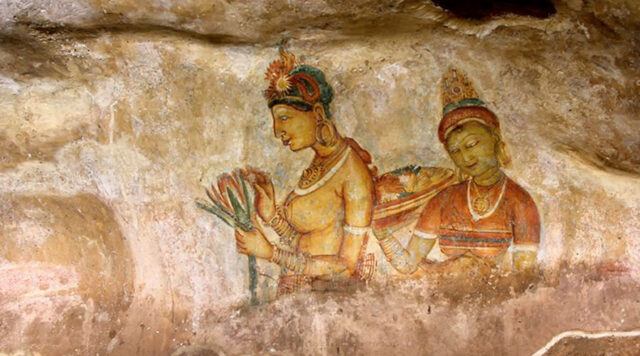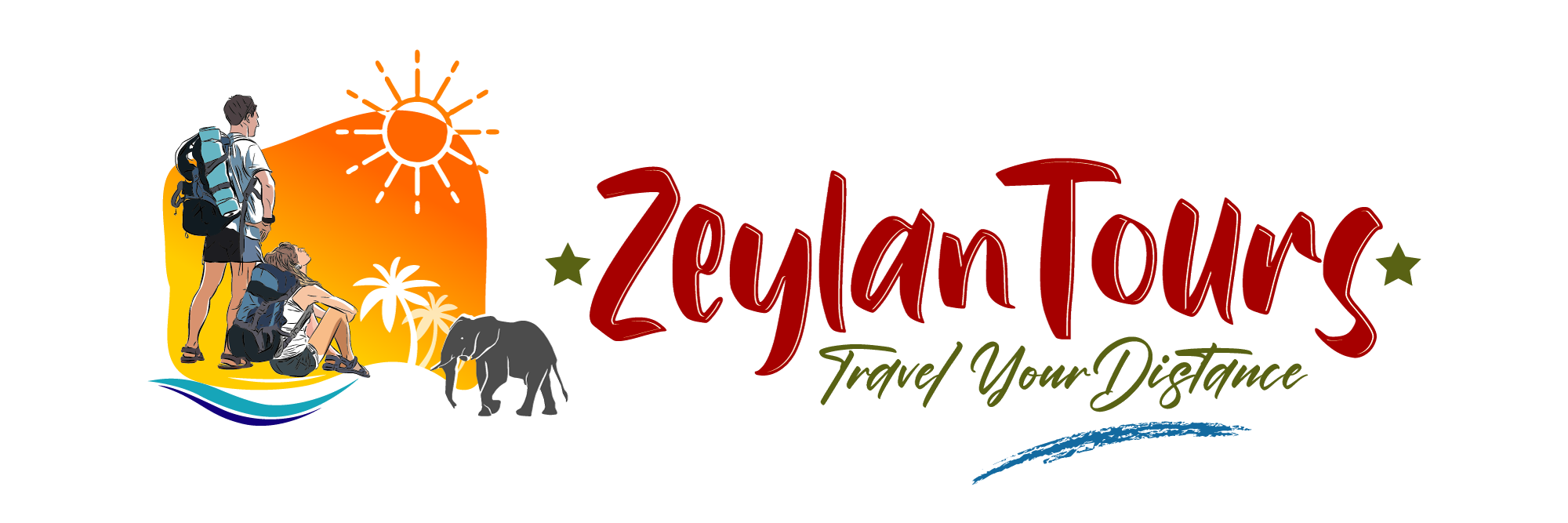The lion rock stands magnificently in the central province, near the town of Dambulla. It is a UNESCO World Heritage Site. Sigiriya is about 600 feet high. And there are 1200 steps to climb. It would take about two/three hours to reach the top. You’ll be able to witness spectacular views from the summit.
 The King Kashyapa who reigned Sri Lanka from 473 to 495 built his castle atop this rock mountain. Many think the shape of this rock is unusual because of its perfectly flat top. It looks as if it’s cut in precise angles. The remnants of the castle, the Lion Gate, gardens, moats, the Mirror Wall, and many beautiful frescoes remain to date. They disclose the glory of the Kashyapa era.
The King Kashyapa who reigned Sri Lanka from 473 to 495 built his castle atop this rock mountain. Many think the shape of this rock is unusual because of its perfectly flat top. It looks as if it’s cut in precise angles. The remnants of the castle, the Lion Gate, gardens, moats, the Mirror Wall, and many beautiful frescoes remain to date. They disclose the glory of the Kashyapa era.
Sigiriya is quintessential to engineering marvels that existed in ancient times. It is estimated that three million bricks had been used to build this site. There were no signs of stairways from the ground to the top of the rock when Sigiriya was discovered in 1831 by Major Jonathan Forbes. So it is a mystery how the ancient builders carried clay bricks and huge blocks of white marble that were not native to the area, onto the top of the rock. The water tank on the top had been built carving into the extremely tough granite rock. 3500 tons of granite would have been removed to make the structure of the pond.
The water gardens at Sigiriya consist of an aggregate of pools, fountains, and lawns. Water was piped from the ponds at the base of the rock mountain up to the castle. Some of the hydraulic irrigation systems still provide water to the area. If you explore more about Sigiriya, you’ll learn more awe-inspiring facts, advanced engineering capabilities, techniques, and technologies that we thought were impossible during this period.
 The polished mirror wall is believed to have covered the whole stairway sidelong the rock face. It was named the mirror wall as the wall plaster was polished to create a mirror effect during the Kashyapa era. After the fall of King Kashyapa, the folks visited the palace and made graffiti describing the beauty of Sigiriya damsels on the mirror wall. The identity of the damsels in these paintings is yet to be confirmed. The scholars believe they are either concubines of the king or celestial nymphs. The women depicted in the frescoes wear beautifully designed jewelry and are adorned with styled hair and clothing. The fact that these paintings have survived for over a thousand years is remarkable.
The polished mirror wall is believed to have covered the whole stairway sidelong the rock face. It was named the mirror wall as the wall plaster was polished to create a mirror effect during the Kashyapa era. After the fall of King Kashyapa, the folks visited the palace and made graffiti describing the beauty of Sigiriya damsels on the mirror wall. The identity of the damsels in these paintings is yet to be confirmed. The scholars believe they are either concubines of the king or celestial nymphs. The women depicted in the frescoes wear beautifully designed jewelry and are adorned with styled hair and clothing. The fact that these paintings have survived for over a thousand years is remarkable.
If one delves into the history of Sigiriya, an intriguing story will be unfolded. The King Kashyapa gained kingship after killing his father. King Kashyapa shifted his kingdom from Anuradhapura to Sigiriya. He built his fortress in a way that was not easy to access for his enemies. Later, Kashyapa repented his actions. He was in quest for mental peace. So he constructed an entire city in a way he can indulge in sensory pleasures. Kashyapa was born to a consort of King Dathusena. Moggalana was born to the queen. So Kashyapa’s younger brother Moggalana was the rightful heir for kingship. Moggalana fled to India as he feared for his life. He wanted to avenge his brother. He organized an army in South India and waged war against Kashyapa. King Kashyapa lost to his brother. King Kashyapa killed himself with his sword as he didn’t want to be apprehended. Eventually, his rule came to an end after twenty-two years.
 There are other tourist attractions in the vicinity of Sigiriya. Sigiriya Archaeological Museum is located just outside the entry gate of Sigiriya. Pidurangala Rock is just 10 minutes’ walk from Sigiriya. It is ideal for hikers and is popular for panoramic views, especially of Sigiriya. The best time to hike at Pidurangala is at sunrise or sunset. The visitors will come across the Pidurangala Sigiri Rajamaha Viharaya at the base and there is a large reclining Buddha statue.
There are other tourist attractions in the vicinity of Sigiriya. Sigiriya Archaeological Museum is located just outside the entry gate of Sigiriya. Pidurangala Rock is just 10 minutes’ walk from Sigiriya. It is ideal for hikers and is popular for panoramic views, especially of Sigiriya. The best time to hike at Pidurangala is at sunrise or sunset. The visitors will come across the Pidurangala Sigiri Rajamaha Viharaya at the base and there is a large reclining Buddha statue.
Matale Aluvihare is situated 63km to Sigiriya. Aluvihare is an ancient temple and holds importance as Buddhist canons that were passed down through oral tradition were written down for the first time in this temple. Dambulla cave temple is also a world heritage site. It is located 19.5km from Sigiriya. Minneriya National Park has an abundance of scrub, forest, and wetlands and is a habitat for various fauna such as elephants, toque macaques, sambar deer, buffalo, crocodiles, and leopards. It is at a distance of 23km from Sigiriya.

